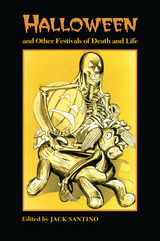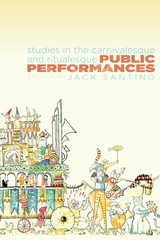
Jack Santino has put together the first collection of essays to examine the evolution of Halloween from its Celtic origins through its adaptation into modern culture. Using a wide variety of perspectives and approaches, the thirteen essayists examine customs, communities, and material culture to reveal how Halloween has manifested itself throughout all aspects of our society to become not just a marginal survivor of a dying tradition but a thriving, contemporary, post-industrial festival. Its steadily increasing popularity, despite overcommercialization and criticism, is attributed to its powerful symbolism that employs both pre-Christian images and concepts from popular culture to appeal to groups of all ages, orientations, and backgrounds. However, the essays in this volume also suggest that there is something ironic and unsettling about the immense popularity of a holiday whose main images are of death, evil, and the grotesque.
Halloween and other Festivals of Death and Life is a unique contribution that questions our concepts of religiosity and spirituality while contributing to our understanding of Halloween as a rich and diverse reflection of our society’s past, present, and future identity.
The Editor: Jack Santino is an associate professor in the department of popular culture at Bowling Green State University, Bowling Green, Ohio.

Jack Santino's interviews with retired porters provide extensive firsthand accounts of their work, the job inequities they faced, the formation of the Brotherhood of Sleeping Car Porters, and the aborted Pullman porter strike of 1928. Through the testimony of ran-and-file workers as well as key figures such as E. D. Nixon, the porter who initiated the Montgomery bus boycott and helped launch the career of Martin Luther King, Jr. and C.L. Dellums, the only surviving founding member of the BSCP, Miles of Smiles, Years of Struggle illuminates the Pullman porters' struggle for dignity.

Public Performances offers a deep and wide-ranging exploration of relationships among genres of public performance and of the underlying political motivations they share. Illustrating the connections among three themes—the political, the carnivalesque, and the ritualesque—this volume provides rich and comprehensive insight into public performance as an assertion of political power.
Contributors consider how public genres of performance express not only celebration but also dissent, grief, and remembrance; examine the permeability of the boundaries between genres; and analyze the approval or regulation of such events by municipalities and other institutions. Where the particular use of public space is not sanctioned or where that use meets with hostility from institutions or represents a critique of them, performers are effectively reclaiming public space to make public statements on their own terms—an act of popular sovereignty.
Through these concepts, Public Performances distinguishes the sometimes overlapping dimensions of public symbolic display. Carnival, and thus the carnivalesque, is understood to possess tacit social permission for unconventional or even deviant performance, on the grounds that normal social order will resume when the performance concludes. Ritual, and the ritualesque, leverages a deeper symbolic sensibility, one believed—or at least intended—by the participants to effect transformative, longer-term change.
Contributors: Roger D. Abrahams, John Borgonovo, Laurent Sébastien Fournier, Lisa Gilman, Barbara Graham, David Harnish, Samuel Kinser, Scott Magelssen, Elena Martinez, Pamela Moro, Beverly J. Stoeltje, Daniel Wojcik, Dorothy L. Zinn
READERS
Browse our collection.
PUBLISHERS
See BiblioVault's publisher services.
STUDENT SERVICES
Files for college accessibility offices.
UChicago Accessibility Resources
home | accessibility | search | about | contact us
BiblioVault ® 2001 - 2024
The University of Chicago Press









